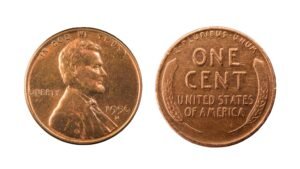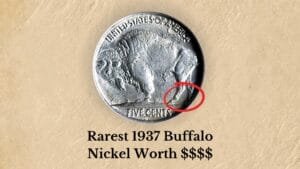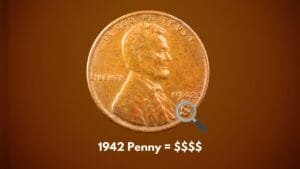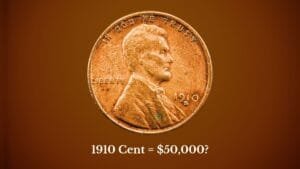With over 1.5 billion coins minted, the 1956 Lincoln Penny might appear as a worthless copper coin at first glance. But what if I told you this ordinary-looking small cent once sold for an eye-popping price of $57,600 in a coin auction?
So, what makes a 1956 penny so valuable? Well, several factors impact its value, such as mint marks, color, and any unique minting errors. In this guide, you’ll learn about all these factors and other features to look for on this small cent!
History of the 1956 Lincoln Wheat Penny
The 1956 Lincoln Wheat Penny is a part of the Post-war Lincoln Cent of the Wheat Penny series. Designed by Victor David Brenner, this series began in 1909 to commemorate the 100th anniversary of Abraham Lincoln’s birth.
The 1956 Wheat Penny was minted at the Philadelphia and Denver mints, with a total mintage of over 1.5 billion coins. It is considered a key date in the series, as it was one of the last Wheat Pennies minted before the design was changed in 1959 to feature the Lincoln Memorial on the reverse, replacing the classic wheat stalks!
| 1956 Lincoln Wheat Cent | Key Features & Facts |
| Coin Composition | 95% Copper, 5% Tin and Zinc |
| Minting Location | Philadelphia, Denver |
| Minting Year | 1956 |
| Face Value | 1-cent (0.01$) |
| Weight | 3.11 grams |
| Diameter | 19.05 mm |
| Thickness | 1.52 mm |
| Designer | Victor David Brenner |
| Mint Marks | D – Denver Mint, No Mint Mark – Philadelphia Mint |
| Total Mintage | 1,519,615,484 |
Understanding a 1956 Wheat Penny Design & Composition
To spot a real 1956 Lincoln Wheat Cent, you must understand the unique design elements on its heads and tails, composition, size, dimensions, and other physical characteristics:
1956 Lincoln Penny Obverse:
- Portrait of Abraham Lincoln facing right
- “IN GOD WE TRUST” inscription above Lincoln’s head
- “LIBERTY” to the left of Lincoln
- The mint date “1956” to the right of Lincoln
- The mint mark “D,” if present, below the mint year
- Designer’s initials “VDB” on Lincoln’s shoulder (may be difficult to see)
1956 Lincoln Penny Reverse:
- Two wheat stalks near the left and right edges (hence the nickname “Wheat Penny”)
- “UNITED STATES OF AMERICA” along the top edge
- “ONE CENT” in large letters in the center
- “E PLURIBUS UNUM” above “ONE CENT”
Coin Composition, Size & Dimensions:
The 1956 Lincoln Cent is composed of 95% copper and 5% tin and zinc. This composition gives the small cent its unique reddish-brown luster when new (old 1956 might be brown) and a weight of 3.11 grams.
Besides, the penny has a diameter of 19.05 mm (0.75 inches) and a thickness of 1.55 mm (0.0610 inches) with a plain uniform edge.
5 Key Factors to Find a 1956 Lincoln Penny Value
A circulated 1956 Lincoln Penny is commonly worth between $0.02 and $0.10, while pennies in uncirculated condition or with rare characteristics can range from $0.50 to several hundred dollars, depending on several factors. Let’s understand these features and factors!
1. Coin Grading and Condition
Your coin’s condition is the most important factor determining its value. Generally, a 1956 Wheat Penny in excellent condition (like a new coin) is worth more than one with significant wear and tear.
While you can analyze the condition based on the details in lettering and raised designs, Professional grading services use a scale from PO1 to MS70, with PO1 being a flawed coin with faded design and MS70 being a perfect coin. 1956 Lincoln Penny graded MS65 can range from $5 to $20+, while MS67 or higher examples can be worth $100 to $15,000!
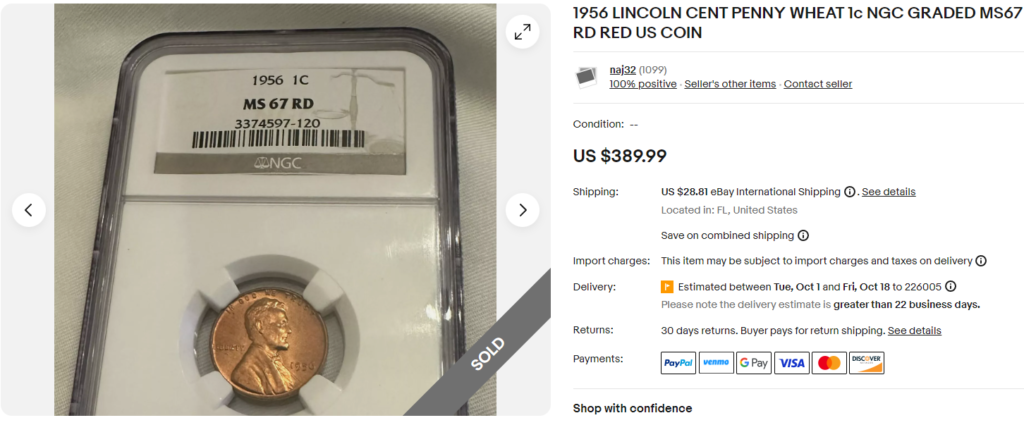
2. Coin Toning & Coloration
The original color of a new 1956 Lincoln Penny is reddish-brown. However, due to oxidation over the years, the cent can eventually become brown.
Depending on this discoloration, 1956 pennies are categorized into three color designations, which can affect their value:
- Red (RD): Red 1956 Wheat Pennies have 95% or more of their original reddish luster and are the most valuable and sought-after. They are worth $0.55 to $5 in a circulated condition, while in uncirculated MS63 to MS67 grades, they can fetch $0.55 to $900. The auction record for a red 1956 Wheat Penny was set in 2022 when an MS67+ piece sold for an astounding $57,600!
- Red-Brown (RB): 1956 cents with 5% to 95% of their original red color are graded RB. These are less valuable than full red coins but more than brown ones. Circulated RB 1956 pennies are worth $0.35 to $1, while uncirculated ones with MS63 to MS67 grades are worth $0.35 to $50!
- Brown (BN): BN coins with less than 5% of their original red luster are graded BN. These are typically the least valuable unless in the highest grades. In circulated and uncirculated conditions (MS63 to MS67 grades), brown 1956 pennies range from $0.25 to $0.55. The highest value of a BN 1956 1C coin is $1,610!
3. Mint Marks & Mintage
The 1956 Lincoln Penny was struck in Philadelphia and Denver. The mintage (or mint mark) of these pennies can impact the coin’s value.
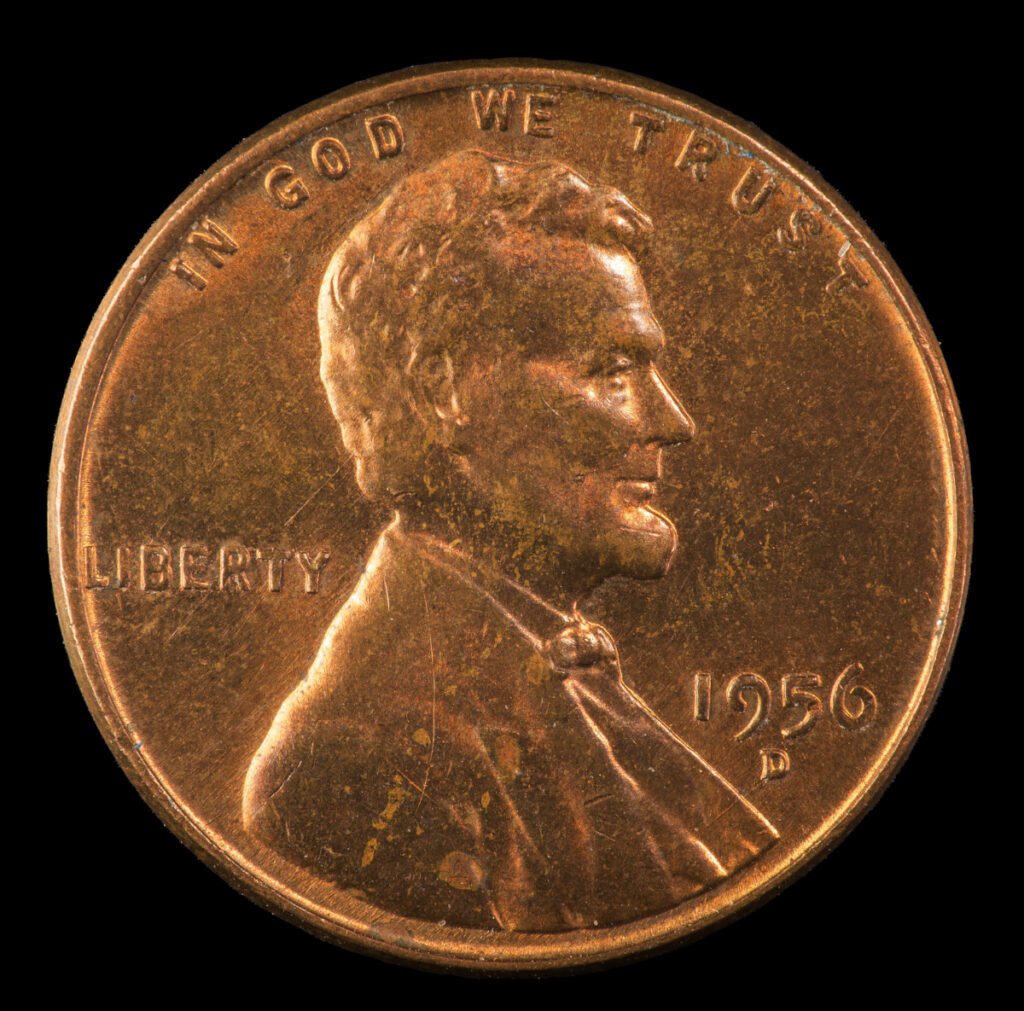
- 1956 No Mint Mark Penny: The Philadelphia Mint produced 420,745,000 Wheat Pennies in 1956, identified by no mint mark. In uncirculated conditions, these 1956 pennies can be worth $0.50 to $5, with high-grade examples reaching up to $15,000.
- 1956 D Wheat Penny: The Denver Mint produced a staggering 1,098,201,100 1956 Wheat Pennies, indicated by the “D” mint mark. While this version is also quite common, uncirculated or error 1956 D wheat pennies can fetch high returns, like this MS67+ example that a collector bought for $18,000 in a coin auction.
You can find your coin’s value using this detailed 1956 Lincoln Cent value chart based on coin grades and mint marks. (The given values are for RD-graded coins.)
| Coin Grades | Condition Details | 1956 No Mint Mark Penny Value | 1956 D Wheat Penny Value |
| Poor (0) to Extremely Fine (XF45) | Significant wear, faded but visible details | Face Value | Face Value |
| Almost Uncirculated (AU50) to Mint State (MS60) | Slight wear on highest points, visible marks or blemishes | 50 cents to $3 | 5 cents to $3 |
| Mint State (MS61 – MS64) | Uncirculated with minimal wear | $5 – $15 | $4 – $10 |
| Mint State (MS65 – MS66+) | Nearly flawless with very minor imperfections | $10 – $120 | $10 – $90 |
| Mint State (MS67 – MS67+) | Well-preserved with no major flaws | $250 – $15,000 | $950 – $4,000 |
| Mint State (MS68 or Above) | Nearly perfect, luster, no major marks or flaws | N/A | N/A |
4. 1956 Lincoln Wheat Penny Proof Coins
Apart from the regular pennies, the United States Mint produced 669,384 proof 1956 Lincoln Pennies at the Philadelphia Mint. These were struck using specially polished dies and planchets, resulting in a mirror-like finish.
Within the proof category, there are three distinct types based on the proof finish: Red, Cameo, and Deep Cameo.
- Regular Proof Coins: Red 1956 Lincoln Proof Coins are characterized by their bright, shiny appearance and vibrant red color. The value of red proof pennies generally ranges from $10 to $200, depending on its condition.
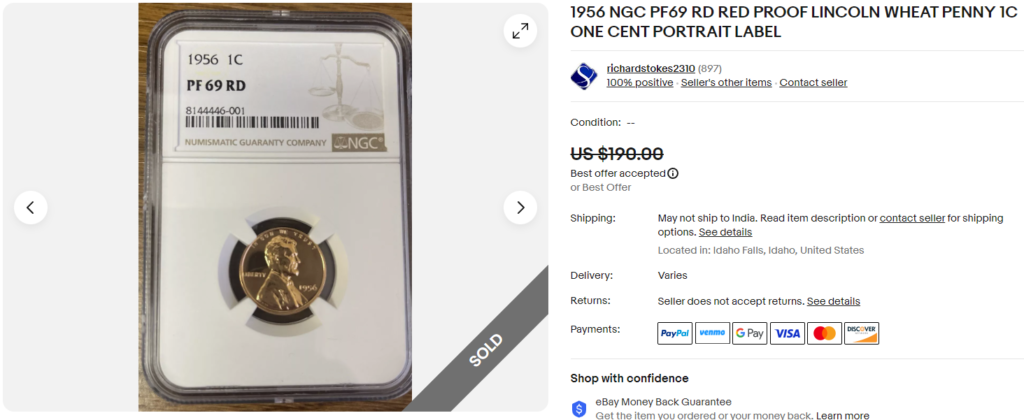
- Cameo Proof Coins: 1956 Cameo proof coins have a contrast between the frosted design and the mirrored background. These proof coins can be worth $20 to $50, with grades like PR68CAM or higher selling for up to $1,000 or more!
- Deep Cameo Proof Coins: 1956 Deep Cameo proof coins have the strongest contrast between the frosted surface and the field. Rarer and more valuable, DCAM 1956 Lincoln-proof pennies can command prices of up to $1,000 to $5,000 in high-proof grades.
5. Rare 1956 Wheat Penny Mint Errors List & Varieties
Mint errors that occurs during the minting process can greatly boost your 1956 Lincoln Penny value. The most notable errors to look for are:
Doubled Die Obverse or Reverse (DDO & DDR)
When a 1956 Wheat Penny is struck twice by the die, it can result in a doubled appearance on the letters and design on the obverse and reverse. Most DDR and DDO 1956 pennies cost $100 to $500, depending on the coin’s condition and doubling. This error can also be found on proof coins, like this PR67RD example, that sold for $600 on eBay!
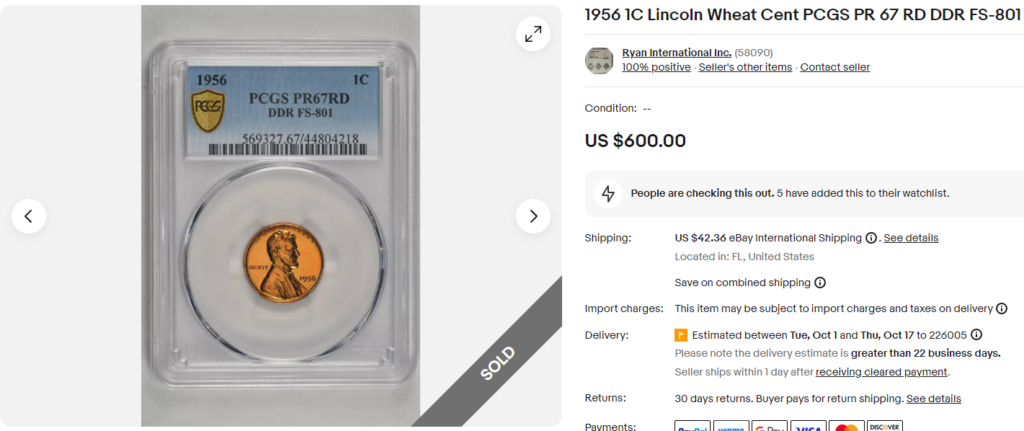
Off-Center Strike Error
If a 1956 wheat penny planchet is not properly centered in the die when struck, it will have a crescent-shaped blank space on the surface. Minor off-center designs can sell for $10 to $50. Those with major off-center designs (50% to 80%) are worth $100 to $300, like this MS64BN example with a 70% off-center design that sold for almost $230 on Heritage Auctions!
Repunched Mintmark (RPM)
You may find some 1956 D Lincoln Wheat Pennies with a doubled or punched “D” mintmark, which happens when the mintmark is accidentally struck twice, creating a shadow effect. A RPM 1956 D Wheat Penny can be worth around $15 to $370, depending on the coin’s condition and the visibility of the punched mark.

Struck on a 10C Silver Dime Planchet
This mint error occurs when a 1956 Lincoln Penny is mistakenly struck on a 10-cent silver dime planchet, resulting in a rare coin with a gray silvery finish instead of a red luster. Depending on the coin’s condition, this error coin can range from $400 to $1,650 or more!

How to Spot a Fake 1956 Wheat Penny in 5 Steps
To ensure you have an authentic 1956 Lincoln Penny, follow these detailed steps to spot a fake:
- Examine the Weight: Start by weighing the coin. A real 1956 Lincoln Penny weighs 3.11 grams. If the weight is significantly off (lighter or heavier), it may be a counterfeit.
- Check the Diameter: Use a caliper to measure the coin. A fake 1956 penny may not match the diameter of 19.05 mm.
- Inspect the Edge: Genuine Lincoln Pennies have a smooth edge, while fakes might have a rough or poorly defined edge. Run your fingers along the edge to check irregularities.
- Look for the Mint Mark: The 1956 pennies produced in Philadelphia do not have a mint mark, while those from Denver will have a “D” mint mark. Check the style and placement of the mint mark.
- Verify the Composition: Since a genuine 1956 Lincoln Penny is made primarily of copper, it should not be magnetic. Use a magnet; if it sticks, it’s likely a fake.
If you’re still unsure about the authenticity of your 1956 Lincoln Penny, consider contacting a professional coin dealer or a grading service!
Note: This article is intended for informational, educational, and entertainment purposes only. Some images are illustrative and may not represent actual brands, products, or related entities. All trademarks, product names, brand logos, packaging, and other intellectual property referenced remain the exclusive property of their respective owners. Any brand mentions or references are provided solely for descriptive and educational context and do not imply any formal or commercial association.

